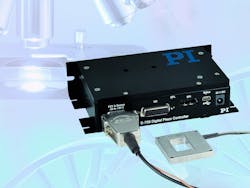PI nanopositioning controller offers two notch filters
The E-709 nanopositioning controller provides fifth-order polynomial digital linearization for higher accuracy than analog, and has two notch filters, piezo operation, and DAC-in-the-loop architecture. It utilizes USB, RS-232, Real Time Analog, and TTL interfaces, and software support includes Windows .dll, Linux .so, and LabVIEW .llbs. Applications include bio- and nanotechnology, semiconductors, lithography, and optics.
PI (Physik Instrumente)
Auburn, MA
[email protected]
-----
PRESS RELEASE
E-709: Affordable Digital Piezo Nanopositioning Controller for the Cost of Analog
Auburn, MA -- piezo system specialist PI introduces a breakthrough development in nanopositioning stage control. The new E-709 provides digital functionality at the price-point of an analog controller, all in the volume of a paperback book! The true digital servo performance comes without compromise:
Features and Advantages
- 5th order polynomial digital linearization ensures higher accuracy than analog
- 2 notch filters allow faster response and piezo operation at higher frequencies
- A fast servo update rate ensures responsiveness
- DAC-in-the-loop architecture guarantees positional stability
- Several high speed interfaces: USB, RS-232, Real Time Analog and TTL
- Easy-to-use setup software for remote access and servo tuning. No trimpots!
- Extensive, well-documented, interface-independent software support includes Windows .dll, Linux .so, and LabVIEW .llbs
Datasheet & More Information: http://www.physikinstrumente.com/en/news/fullnews.php?newsid=169
Digital Piezo Control Functionality at a Breakthrough Price-
One-Third of the Nearest Competitor
The E-709 opens up the possibilities of digital control for piezo-driven nanopositioning systems for the same price as analog controllers. It was designed for piezo actuators and nanopositioning stages which low-cost piezoresistive sensors and the higher performing capacitive sensors. The digital servo technology allows higher linearity and precision and provides more control options (changeing parameters on-the-fly, software optimized servo tuning, etc) and very comfortable operation. The E-709 also includes a piezo power amplifier (driver). No additional hardware is required to operate a piezo mechanics.
Comprehensive Software Support
In addition, PI provides the full functionality of its comprehensive software packages free of charge. The E-709 can also be used for applications providing analog control signals, as still widely used in microscopy applications. In addition to 2 digital interfaces, a standard broadband analog input is installed as well.
True Digital or Analog?
Many "digital" piezo nanopositioning controllers are actually analog controllers with a USB or other communications interface grafted on. The digital command is converted into an analog voltage by a D/A converter that sits outside the servo loop and feeds the analog voltage to the servo. The servo technology in these controllers remains analog (op-amps, capacitors, resistors), with its inherent limits in accuracy, stability and functionality. A true digital controller puts the DAC inside the servo loop.
Application Examples
- Bio/Nanotechnology
- Semiconductor Technology
- Lithography, Optics
-----
Subscribe now to Laser Focus World magazine; it's free!
